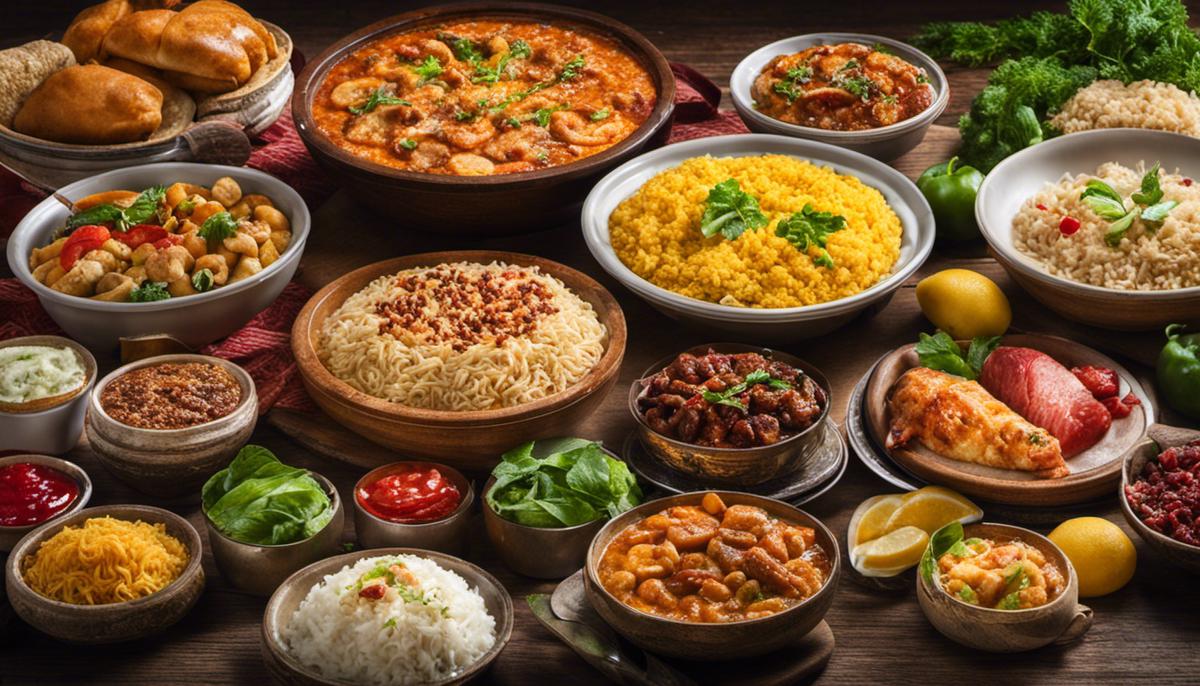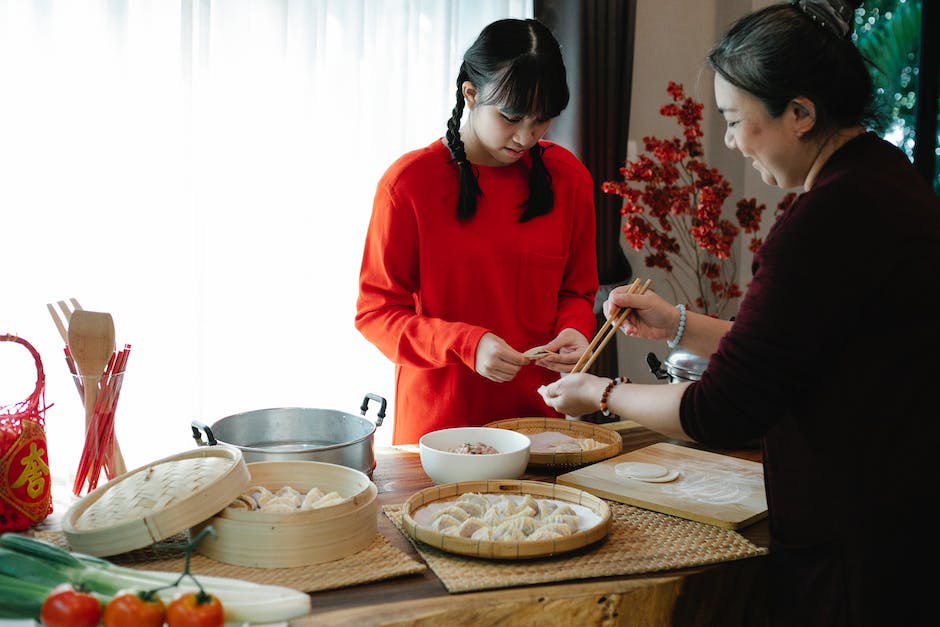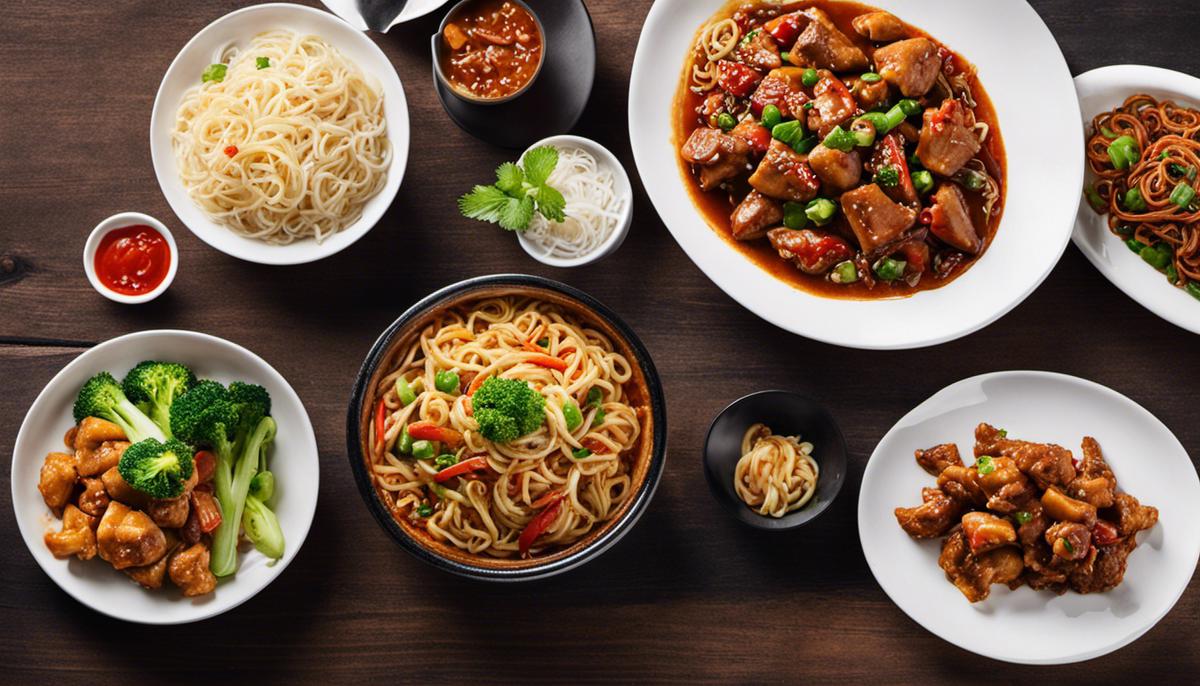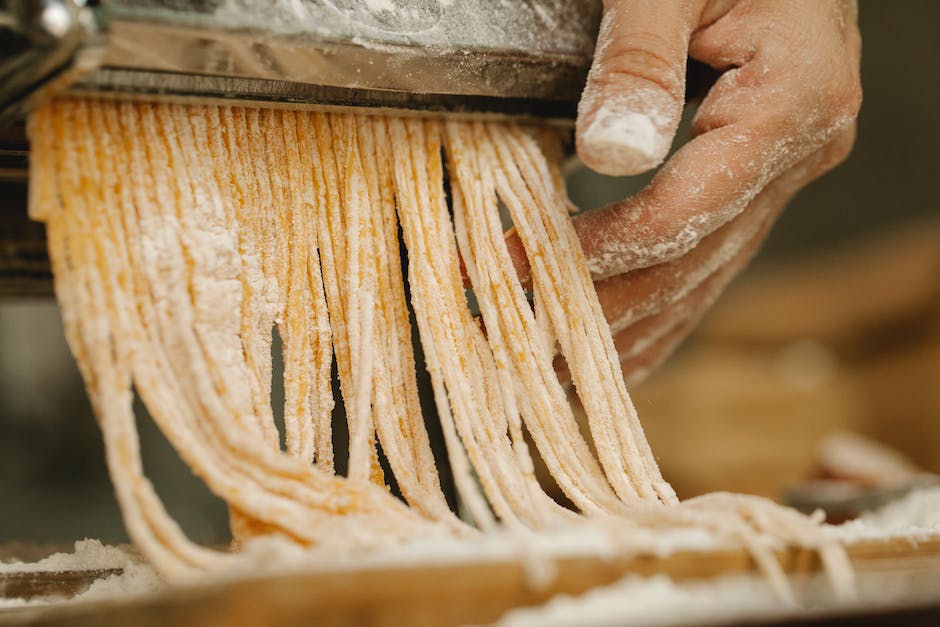Virtually all cultures around the globe have a profound connection to their traditional food, shaping their identities while providing a comfortingly familiar taste. Halal Chinese food, an engaging fusion of Islamic dietary laws and traditional Chinese cuisine, serves as an intricate testimony to this universal truth. Exploring Halal cuisine is far more than a gastronomic journey; it’s a deep dive into centuries-old culinary practices, honed by faith and culture. This exploration will bring us closer to understanding Halal food, its significance, and the history of Chinese cuisine in Muslim culture. It will also open up our palate to popular Halal Chinese dishes, and finally, help us comprehend the growing trend and demand for Halal Chinese food worldwide.
Understanding Halal Food
Understanding Halal Food
Halal food is a type of dietary practice observed by individuals who follow Islam. These practices are based on specific commands outlined in the Quran, the holy book of Islam. The term “Halal” means permissible in Arabic, and refers to food items that are allowed by Islamic law for consumption.
The Islamic dietary laws govern not only the types of food that can be consumed, but also the methods of preparation and handling. For instance, animals must be slaughtered in a certain manner that is considered humane and compassionate in Islam. The slaughter should be performed by a Muslim, who must invoke the name of Allah before the process. Crucial to note also is the prohibition of certain types of food, including pork and any products derived from it, alcohol, and carnivorous animals.
The halal certification is an important factor in identifying whether or not a food item is permissible for consumption according to Islamic law. This certification is granted by recognized Islamic organizations and signifies that a given product is in compliance with halal standards. It provides assurance to Muslim consumers that the food product they are purchasing is halal.
There are a number of misconceptions about halal food, one of which is that it is unhealthy or inferior in some way. However, the halal food certification process is stringent, and the food is often fresher and more wholesome. Another misconception is that all Middle Eastern or Arabic food is halal, but this is not necessarily the case. It only becomes halal when it conforms to Islamic dietary laws.
Halal Chinese Food
Chinese cuisine is one of the most diverse in the world, and has been widely embraced by many cultures. However, traditional Chinese cuisine may contain food items that are considered haram, or forbidden, in Islam. These can include certain types of meat, as well as dishes that contain alcohol.
As a result, halal Chinese food has emerged, which adapts the flavor diversity of Chinese cuisine to the dietary laws of Islam. Halal Chinese food replaces forbidden items with halal alternatives and ensures that the preparation process adheres to halal practices. For instance, pork is commonly used in traditional Chinese dishes but will be replaced with halal meats such as chicken, beef or mutton in halal Chinese cuisine.
Not all Chinese food is automatically halal. Therefore, if you are adhering to a halal diet, always ensure that your food is sourced from certified halal Chinese outlets.
Understanding Halal Chinese Cuisine
Grasping the concept of halal food requires an understanding of not only its specific dietary rules, but also the crucial significance of the procedures employed in ensuring the adherence to these restrictions. In the realm of adapting cuisines such as Chinese to align with halal guidelines, this often means some traditional ingredients may not feature in your menu. However, this certainly does not equate to having to compromise on the delectable flavors that you adore.

History of Chinese Cuisine in Muslim Culture
The Fusion: Halal Practices Meet Chinese Culinary Arts
A journey back in time to the Tang Dynasty era (618-907) reveals the foundations of Chinese cuisine in the Muslim world. During that period, traders and diplomats from Arab nations, Persia, and Central Asia made their way to China using the famous Silk Road trade pathway. With them, they carried their religious beliefs, cultural practices, and cooking techniques, which over time, amalgamated with the Chinese customs. This organic fusion of cultures ultimately gave birth to a unique gastronomic style often referred to as “Halal Chinese Cuisine” or “Hui Cuisine”.
Geographical Influences on Halal Chinese Cuisine
Muslims in China are mainly concentrated in the northwestern provinces of Ningxia, Gansu, and Xinjiang, which have notable influences on the Halal Chinese food. These regions are not only rich in lamb and beef, which is consumed widely in Islamic cuisine due to the prohibition of pork, but also in a variety of spices such as cumin and pepper, resulting in a distinct flavor profile. The influence of Halal food is also significant in major Chinese cities with large Muslim populations such as Beijing, Xi’an, and Lanzhou.
Adaptation of Chinese Dishes to Comply with Islamic Dietary Laws
Traditional Chinese dishes were greatly modified to comply with Islamic dietary laws, for Muslims’ strict adherence to food laws known as Halal. Pigs, dogs, donkeys, and animals that die of themselves are deemed Haram (forbidden), leading to the exclusion of pork, a mainstay in traditional Chinese cuisine. Similarly, the use of alcohol, which features heavily in many Chinese dishes, is also avoided in Halal Chinese cuisine.
Instead, Muslim Chinese chefs innovated and developed new dishes using Halal-approved ingredients. The wide use of mutton, beef, chicken, and duck is typical of Halal Chinese food. Moreover, Chinese cooking techniques such as stir frying, roasting, braising, steaming, and boiling are commonly used in the preparation of these Halal dishes.
Historical Events Influencing the Growth of Halal Chinese Food
Historical events like the Yuan Dynasty’s policy of religious tolerance facilitated the spread of Islam and indirectly, the Halal food business flourished. Further down the history during the Ming and Qing dynasties, Muslim artisans and merchants, including cooks, formed guilds, thus encouraging the development of Halal culinary skills.
Famous Halal Chinese Dishes
There are several famous Chinese dishes that have been adapted to fit within halal dietary laws. These include Lamian (hand-pulled noodles), beef or mutton Rou Jia Mo (Chinese hamburger), and Yang Rou Pao Mo (crumbled flatbread in mutton stew), which are particularly famous in Xi’an’s Muslim Street. Other traditional adaptations include Beijing-style roasted duck, which is cooked with Halal-approved ingredients while still retaining the overall taste profile.
Current Progressions in Halal Chinese Cuisine
In our present day, the age-old tradition of Halal Chinese food continues its growth, dynamically blending ingredients from various regional and international cuisines while maintaining its obedience to Halal tenets. The global spread of Chinese Muslim immigrants has introduced this unique cuisine to new cultures worldwide, massively boosting its global reputation and demand.

Popular Halal Chinese Dishes
Frequented Halal Chinese Menu Selections
In the expansive and diverse world of Chinese cuisine, a surprising multitude of dishes can be tailored to align with halal dietary restrictions. Within these restrictions, as laid out by Islamic dietary laws, pork and its derivatives, animals that were not alive at the time of slaughter, blood and its byproducts, and alcoholic beverages are strictly prohibited.
Halal Kung Pao Chicken is a prime example of a frequently sought-after halal Chinese dish. This dish skillfully combines diced, marinated chicken with peanuts, vegetables and fiery chili peppers. Key to the dish’s halal certification is the use of chicken as the protein source and an intentional avoidance of cooking wine, which is a common ingredient in the vast majority traditional Chinese dishes.
Chinese Beef Stir-Fry is another highly regarded halal-friendly Chinese dish that is frequently featured in Halal Chinese restaurants. This savory plate features slices of marinated beef stir-fried with a myriad of vegetables in a rich, soy-based sauce. Crucial for its acceptance as a halal dish is the origin of the beef; it must be certified as halal, illustrating that the associated animal was slaughtered as per Islamic protocols.
Lastly, Shanghai Style Fried Noodles also sits high on the list of likable halal Chinese dishes. It presents a classic culinary experience with thick, linguini-style noodles tossed with shredded chicken or beef, bell peppers, onions, and bean sprouts. With mindful selection of halal ingredients and proper meat preparation, this dish is easily made consistent with halal standards.
Cooking Methods and Ingredients in Halal Chinese Dishes
Chinese cooking techniques, such as stir-frying, steaming, braising, and boiling, are conducive to halal cooking since no prohibited methods are typically involved. However, it is essential to monitor other ingredients that might traditionally be used in Chinese cooking but are not halal, such as certain sauces like oyster sauce or soy sauces that may contain traces of alcohol.
While cooking these dishes at home, it’s crucial to purchase halal certified meats. It means that the meat comes from a supplier that slaughters livestock according to Islamic regulations. For people looking to purchase halal-certified products, they can be found at halal meat stores or supermarkets offering halal choices.
Exploring Halal Chinese Cuisine: Dining and Takeout
Hundreds of restaurants worldwide specialize in halal Chinese cuisine, providing a culinary haven for the Muslim community. Interestingly, the savory and quality meals offered by these eateries are not enjoyed by Muslims alone but also by foodies who appreciate the distinct taste of Chinese cuisine cooked in adherence to Islamic law. To assure their customers, these restaurants visibly display their halal certifications, which verify compliance with the stringent legal, sanitary, and dietary standards of the Islamic law.
With the recent boom in the takeout culture, most of these halal Chinese cuisine outlets have incorporated delivery and pickup services into their operations. This ensures that their customers can savor the exceptional taste of halal Chinese dishes from their homes’ comfort. To find these eateries, a simple internet search or sifting through various food delivery applications with a ‘halal’ filter will do the trick.

The Growing Trend of Halal Chinese Food
The Growing Popularity of Halal Chinese Food
The demand for Halal Chinese food has been on a steady rise across the globe, primarily driven by an expanding Muslim population and an increase in Muslim tourists. This growing preference for Halal foods has influenced a distinct shift towards Halal Chinese cuisine in the global food market. Today, a vast array of Halal-friendly Chinese dishes, such as Kung Pao Chicken and Chow Mein, have found international fame, underscoring the global acceptance and mainstream popularity of Halal Chinese food.
Halal-Certified Chinese Restaurants
With the rising popularity, there has been a significant increase in halal-certified Chinese restaurants worldwide. More restaurants are seeking halal certification to cater to this demographic, widening the culinary variety available to Muslim consumers and making eating out more inclusive for this community. Halal Chinese restaurants adhere to strict Islamic dietary laws, which include avoiding pork and alcohol.
Influence of Current Trends
Current food trends are hugely instrumental in the growing popularity of halal Chinese food. With culinary globalization, Chinese food’s universal appeal has expanded beyond national and cultural borders. When combined with the respect for differing dietary requirements seen in recent years, it’s understandable why Halal Chinese food is gaining ground. Additionally, the trend of ‘food tourism,’ where visitors seek out local culinary experiences, is encouraging the spread of Halal Chinese cuisine. Halal food tourism has particularly become a significant business strategy for many Chinese restaurants now.
Testimonies from Different Cultures
People of different cultures have embraced the Halal Chinese food trend wholeheartedly. The diversity in Chinese cuisine, coupled with adherence to halal dietary laws, has made it relatable and enjoyable to a broad spectrum of consumers. Social media is rife with testimonials of individuals from different cultures expressing their love for Halal Chinese food. From Muslim food bloggers in the West trying ‘Halal Chinese food hauls’ to non-Muslims enjoying authentic Chinese taste in a new, halal-certified dimension, the echo has been overwhelmingly affirmative.
The Global Impact – Halal Chinese Food
The global heightening demand for Halal Chinese food is reshaping the culinary landscape in many regions. Apart from just being an option for those following Islamic dietary laws, Halal Chinese food has come to symbolize an inclusive culinary culture that respects and caters to individual dietary choices and requirements. It underscores the fact that food can transcend cultural and religious boundaries and bring people together. The steep upturn in demand for Halal Chinese food subtly highlights an evolving, inclusive global food trend that celebrates diversity and mutual respect.

Food is undeniably a bridge that connects different cultures, faiths, and people, even in our diversely populated world. The global popularity and demand for Halal Chinese food bear testament to this fact. From its roots in intricate Islamic dietary laws to its growth within the Muslim Chinese communities, this fusion cuisine has found a place at dining tables worldwide. It’s not just about the dishes, their ingredients, or the cooking methods – it’s the tale of human perseverance, cultural blend, religious faith, and the miraculous art of turning simple ingredients into delicious sustenance. With each bite, one is not only satiating their hunger but also partaking in a rich, historical tapestry that nourishes the soul and the mind.
